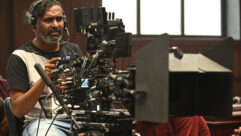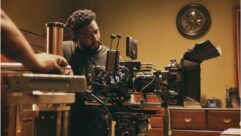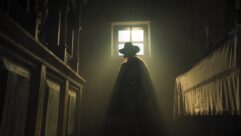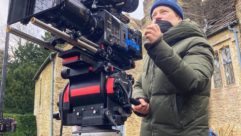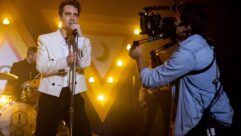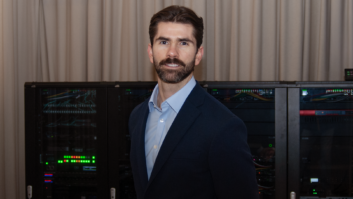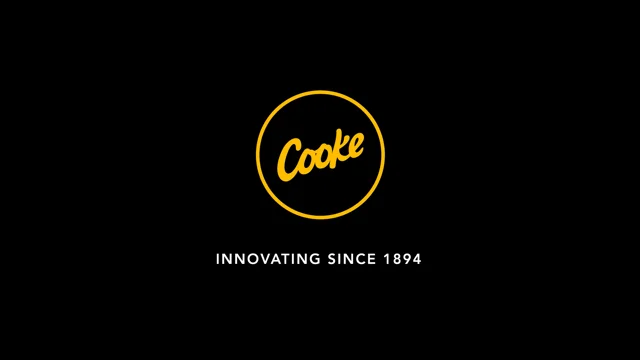
Leicester, UK – 1 November 2023 – Leo is the third film in the Lokesh Cinematic Universe. Inspired by the A History of Violence graphic novel series, Lokesh Kanagaraj’s Tamil-language action thriller follows family man Parthi who resides in Northwestern India where he owns a coffee shop and helps the local forest ranger rescue animals. His attempts to keep a low profile fall short after he saves the townsfolk from a wild spotted hyena and makes national news. An army of crazed and dangerous gangsters begin to hunt Parthi, obsessed with their belief that he is in fact Leo, a master criminal and son of their kingpin Antony Das. Parthi must fight to protect his family and convince them of his innocence.
Leo was released in cinemas worldwide in October 2023 and cinematographer Manoj Paramhamsa spoke to Cooke Optics about his experience on the film and use of the Cooke® Anamorphic/i FF lenses whilst working on the Dolby Vision trims for the film’s Netflix release.
Manoj previously worked with leading man Vijay firstly as a camera assistant from 2006 onwards and later as a cinematographer. It was the lead actor who suggested the cinematographer to director Lokesh, in part because of his previous confidence in handling complex shots and visual effects. Despite the action-heavy nature of the film, Manoj was drawn firstly to the protagonist’s journey.
“I just thought the script was more pronounced on the actor’s performance, the protagonist is more about how he’s trying to protect his identity, said Manoj. “That’s the theme. So, I thought more than any backdrops or any locations, or for any lighting kind of things, I thought it was really important to stick to the basics of getting the performance.”
Manoj and Lokesh’s early discussions quickly migrated towards the question of optics and format.
“The production team and Netflix wanted to shoot in full frame 1.85 ratio, but Lokesh is a person who is very strict in not using 1.85 – he wanted Cinemascope 2.39. Although he didn’t have the option to shoot film, at least he wanted to keep the aspect ratio the same as if he did. So, while it was no to 1.85 – why not use anamorphic? “That is how I ended up going for this. I tested a few other anamorphics, but out of all of them, it was the Cooke lenses that stood out really well.”
Pairing the lenses with a variety of RED cameras headed up by the V-Raptor XL at 8K resolution, Manoj muses; “Anamorphic gives a little more three-dimensional feel that the subject is isolated from the background, and it gives a much more prominent feel. The good thing about this particular 1.8x anamorphic and full frame pairing with the Raptor is I’m getting more POV with anamorphics than super35 and that is a big takeaway.”
Prep was extensive with Manoj’s expertise in pre-visualisation allowing him to maintain ownership of the process. As the co-founder of ‘Stage Unreal’, along with esteemed VFX supervisor Srinivas Mohan, the team had access to a cutting edge set of tools. Major portions of the film were pre-vized in 3D space inside of Unreal Engine allowing for real-time experimentation. Guidance would come in from the stunt choreographer and director from which Manoj could accurately simulate his shots with the same sensor size and focal lengths he’d have access to during the shoot.
With a schedule of some 125 days, Leo shot across a variety of locations including Kashmir in intense winter snow. Manoj credits both his on-set team and pre-lighting crew with making this schedule work. With only so much provision for pre-lighting the pre-visualisation aided Manoj in managing where to prioritise his resources along with matching exterior locations with interior builds.
“The interior was built in the studio,” explained Manoj. “For example, the night coffee shop was entirely built in a studio space. We did a recce of the location and the coffee shop is very small but the exterior was so beautiful in Kashmir so we just bridged it, all the exteriors were real locations, all the interiors were in studio sets. Even the house was like that. We found one beautiful house in Kashmir, we extended compound walls and we put some more grass and stuff to give more chase space. Instead of using a greener screen I tried to use a lot of haze and fog and kept the depth, that’s what we did for the windows, mostly all the interiors are set pieces.”
Manoj is no stranger to Cooke lenses; he was the first Indian cinematographer to use the S4®s which he paired with 3-perf 35mm on an ARRI 235 – after that he utilised the 5/i’s before jumping to 35mm anamorphic films and then later full frame spherical digital. Leo marks his return to Cooke, combining full frame RED with anamorphic.
“I’m so happy, and the next film which I’m presently doing will be the same setup.”
With engaging and pacey camera movement throughout the film, Manoj employed a variety of rigs including FPV drones and the ARRI Trinity system. The RED V-Raptor XL acted whenever possible as the hero camera. The main lenses were the Cooke 32mm, 50mm, 85mm Macro, 135mm and 180mm 1.8x Squeeze full frame Anamorphic/i with the “special flair” coating – a personal set of Manoj’s. The 85mm Macro in particular proved to be invaluable for bold closeups reflective of Parthi’s intensity.
“We wanted to keep the subject closer,” said Manoj “This 85mm Macro was everyone’s favourite lens. So, whenever Lokesh wants something dramatic we go for the 85mm. The 32mm is beautiful, because all the lines are curved. It was really interesting to have that filmic distortion with the 32mm. These are my two favourites.”
On his previous films with Cooke spherical lenses, Manoj had utilised low intensity Tiffen Glimmerglass but beyond internal NDs he used no filtration on Leo.
“Cooke itself is so creamy and buttery, so I didn’t want to use any filtration. The eyes are sharp and the skin is soft. So that is something which we really like to have. And the lens gives it very easily.”
Manoj aimed to keep his shooting stop between T4 and T5.6 finding that the bokeh and depth of field was to everyone’s taste within that range.
Most dialogue scenes were covered with three cameras as Lokesh and the stars preferred to complete them with less takes. This was aided by Manoj’s approach to lighting which primarily utilised LED fixtures.
“Performance is very important for this film so all the drama and all of the dialogue scenes are shot with three cameras so we maintain a visual consistency throughout the film. I use the latest Gemini panels; this hard light and new colour engine gives RGBWW is sharp and the light is so beautiful and so useful. I did a lot of pre light and it’s all rigged and everything will be controlled through the app. Because the look is not a soft glossy look, we are able to use multiple cameras with this particular light. I didn’t use much HMI or PAR light as that harshness would definitely be jarring with multiple angles. The Gemini hard light gave the perfect balance to me.”
Another advantage of the harder LED lights was the ability to give extra punch whenever it was needed for the regular employment of variable frame rates. Primarily this work was carried out on the RED cameras up to 120fps but for particular sequences the production employed a Phantom for even higher speeds.
Manoj’s likened his development of the lighting and colour tone throughout the film as “heading towards a volcano”, beginning with a much cooler look which gradually has elements of firelight and warmer sources introduced into it before “descending into the lava” and thus gaining a much stronger orange tint in the final act.
Preferring to utilise flares at very specific moments, instead of overusing them as might be expected from a film of this genre, the cinematographer was very precise with his lighting with regards to this. A few montage sequences set to an intense energetic soundtrack did give Manoj his opportunity to indulge.
As Manoj explains, “I basically didn’t want to disturb the emotional moments. But when it’s music alone I know people will understand the scene and there is going to be a big background score going on. Then I enhance the flares; otherwise sometimes I feel that we might be overdoing it – I just kept it for the music bits – not for the conversational part. Using lights at a physically lower level and not trying to simulate sunlight with HMI allowed me to control flares better.”
Manoj used a one LUT workflow which he developed in prep with his regular colourist Glen Castinho of Poland’s Alvernia Studios. Finishing in Dolby vision allowed the inclusion of more details in the highlights, especially within the snow and firelight-heavy scenes. Manoj aimed for a vibrant HDR-esque look for the cinematic prints as well.
When it came to VFX these were led by the pre-visualisation process and Manoj utilised live preview overlays on set for particular sequences, including the final chase and battle scenes which were set against a background of mist and snow. Cooke supported the production and VFX vendor MPC to aid in accurate compositing.
In summary, for Manoj the Cooke Anamorphic/i FFs overcame his three prior concerns of anamorphic lenses: skin tones, field of view, and close focus.
“I’m so happy because without any filtration, I’m getting the softness I need and the little warmth on the skin is really pleasant,” said Manoj. “This is what we like for the Indian skin, the little warmth always helps. That’s why we were so happy with the entire Cooke range. The major issue with anamorphic before this, it’s all super35 so field of view is not enough and the third factor is close focus. These are the points why we won’t go for anamorphic. These are the three restrictions, but the Cookes covered all those things. The 85mm Macro gave us the close focus and they cover full frame for field of view. This particular set, delivered everything a cinematographer needs, it covers everything.”


